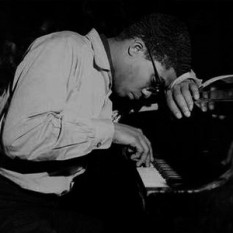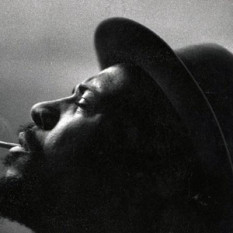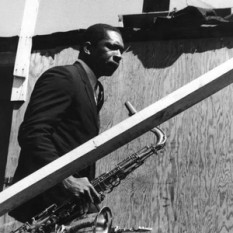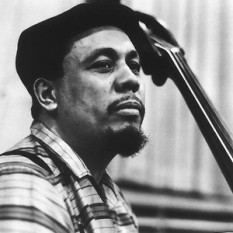Miles Davis (Miles Dewey Davis III, Alton, Illinois, May 26, 1926 – Santa Monica, California, September 28, 1991) was an American trumpeter, bandleader and composer.
Widely considered one of the most influential musicians of the 20th century, Miles Davis was, with his musical groups, at the forefront of several major developments in jazz music, including bebop, cool jazz, hard bop, modal jazz, and jazz fusion. Many well-known musicians rose to prominence as members of Davis' ensembles, including saxophonists Gerry Mulligan, John Coltrane, Cannonball Adderley, George Coleman, Wayne Shorter, Dave Liebman, Branford Marsalis and Kenny Garrett; trombonist J. J. Johnson; pianists Horace Silver, Red Garland, Wynton Kelly, Bill Evans, Herbie Hancock, Joe Zawinul, Chick Corea, and Keith Jarrett; guitarists John McLaughlin, John Scofield and Mike Stern; bassists Paul Chambers, Ron Carter, Dave Holland, Marcus Miller and Darryl Jones, ; and drummers Philly Joe Jones, Tony Williams, Billy Cobham, Jack DeJohnette, and Al Foster.
Miles Davis was born on May 26, 1926, to a relatively affluent family in Alton, Illinois. His father, Dr. Miles Henry Davis, was a dentist. In 1927 the family moved to East St. Louis, Illinois. They also owned a substantial ranch in northern Arkansas, where Davis learned to ride horses as a boy.
Davis' mother, Cleota Mae (Henry) Davis, wanted her son to learn the piano; she was a capable blues pianist but kept this fact hidden from her son. His musical studies began at 13, when his father gave him a trumpet and arranged lessons with local musician Elwood Buchanan. Davis later suggested that his father's instrument choice was made largely to irk his wife, who disliked the trumpet's sound. Against the fashion of the time, Buchanan stressed the importance of playing without vibrato; he was reported to have slapped Davis' knuckles every time he started using heavy vibrato. Davis would carry his clear signature tone throughout his career. He once remarked on its importance to him, saying, "I prefer a round sound with no attitude in it, like a round voice with not too much tremolo and not too much bass. Just right in the middle. If I can’t get that sound I can’t play anything." Clark Terry was another important early influence.
By age 16, Davis was a member of the music society and playing professionally when not at school. At 17, he spent a year playing in Eddie Randle's band, the Blue Devils. During this time, Sonny Stitt tried to persuade him to join the Tiny Bradshaw band, then passing through town, but Davis' mother insisted that he finish his final year of high school.
In 1944, the Billy Eckstine band visited East St. Louis. Dizzy Gillespie and Charlie Parker were members of the band, and Davis was brought in on third trumpet for a couple of weeks because the regular player, Buddy Anderson, was out sick. Even after this experience, once Eckstine's band left town, Davis' parents were still keen for him to continue formal academic studies.
In the fall of 1944, following graduation from high school, Davis moved to New York City to study at the Juilliard School of Music.
Upon arriving in New York, he spent most of his first weeks in town trying to get in contact with Charlie Parker, despite being advised against doing so by several people he met during his quest, including saxophonist Coleman Hawkins.
Finally locating his idol, Davis became one of the cadre of musicians who held nightly jam sessions at two of Harlem's nightclubs, Minton's Playhouse and Monroe's. The group included many of the future leaders of the bebop revolution: young players such as Fats Navarro, Freddie Webster, and J. J. Johnson. Established musicians including Thelonious Monk and Kenny Clarke were also regular participants.
Davis dropped out of Juilliard, after asking permission from his father. In his autobiography, Davis criticized the Juilliard classes for centering too much on the classical European and "white" repertoire. However, he also acknowledged that Juilliard helped give him a grounding in music theory that would prove valuable in later years.
Davis began playing professionally, performing in several 52nd Street clubs with Coleman Hawkins and Eddie "Lockjaw" Davis. In 1945, he entered a recording studio for the first time, as a member of Herbie Fields's group. This was the first of many recordings to which Davis contributed in this period, mostly as a sideman. He finally got the chance to record as a leader in 1946, with an occasional group called the Miles Davis Sextet plus Earl Coleman and Ann Hathaway—one of the rare occasions when Davis, by then a member of the groundbreaking Charlie Parker Quintet, can be heard accompanying singers. In these early years, recording sessions where Davis was the leader were the exception rather than the rule; his next date as leader would not come until 1947.
Around 1945, Dizzy Gillespie parted ways with Parker, and Davis was hired as Gillespie's replacement in his quintet, which also featured Max Roach on drums, Al Haig (replaced later by Sir Charles Thompson and Duke Jordan) on piano, and Curley Russell (later replaced by Tommy Potter and Leonard Gaskin) on bass.
With Parker's quintet, Davis went into the studio several times, already showing hints of the style for which he would become known. On an oft-quoted take of Parker's signature song, "Now's the Time", Davis takes a melodic solo, whose unbop-like quality anticipates the "cool jazz" period that would follow. The Parker quintet also toured widely. During a stop in Los Angeles, Parker had a nervous breakdown that landed him in the Camarillo State Mental Hospital for several months, and Davis found himself stranded. He roomed and collaborated for some time with bassist Charles Mingus, before getting a job on Billy Eckstine's California tour, which eventually brought him back to New York. In 1948, Parker returned to New York, and Davis rejoined his group.
The relationships within the quintet, however, were growing tense. Parker's erratic behavior (attributable to his well-known drug addiction) and artistic choices (both Davis and Roach objected to having Duke Jordan as a pianist and would have preferred Bud Powell) became sources of friction. In December 1948, disputes over money (Davis claims he was not being paid) began to strain their relationship even further. Davis finally left the group following a confrontation with Parker at the Royal Roost.
For Davis, his departure from Parker's group marked the beginning of a period in which he worked mainly as a freelancer and as a sideman in some of the most important combos on the New York jazz scene.
In 1948 Davis grew close to the Canadian composer and arranger Gil Evans. Evans' house had become the meeting place for several young musicians and composers (including Davis, Roach, pianist John Lewis, and baritone sax player Gerry Mulligan) unhappy with the increasingly virtuoso instrumentalism that dominated the bebop scene of the time. Evans had been the arranger for the Claude Thornhill orchestra, and it was the sound of this group, as well as Duke Ellington's example, that suggested the creation of an unusual line-up: a nonet including a French horn and a tuba (this accounts for the "tuba band" moniker that was to be associated with the combo).
Davis took an active role in the project, so much so that it soon became "his project". The objective was to achieve a sound similar to the human voice, through carefully arranged compositions and by emphasizing a relaxed, melodic approach to the improvisations.
The nonet debuted in the summer of 1948, with a two-week engagement at the Royal Roost. The sign announcing the performance gave a surprising prominence to the role of the arrangers: "Miles Davis Nonet. Arrangements by Gil Evans, John Lewis and Gerry Mulligan". It was, in fact, so unusual that Davis had to persuade the Roost's manager, Ralph Watkins, to allow the sign to be worded in this way; he prevailed only with the help of Monte Kay, the club's artistic director.
The nonet was active until the end of 1949, along the way undergoing several changes in personnel: Roach and Davis were constantly featured, along with Mulligan, tuba player Bill Barber, and alto saxophonist Lee Konitz, who had been preferred to Sonny Stitt (whose playing was considered too bop-oriented). Over the months, John Lewis alternated with Al Haig on piano, Mike Zwerin with Kai Winding on trombone (Johnson was touring at the time), Junior Collins with Sandy Siegelstein and Gunther Schuller on French horn, and Al McKibbon with Joe Shulman on bass. Singer Kenny Hagood was added for one track during the recording sessions.
The presence of white musicians in the group angered some African American jazz players, many of whom were unemployed at the time, but Davis rebuffed their criticisms.
A contract with Capitol Records granted the nonet several recording sessions between January 1949 and April 1950. The material they recorded was released in 1956 on an album whose title, Birth of the Cool, gave its name to the "cool jazz" movement that developed at the same time and partly shared the musical direction begun by Davis' group.
For his part, Davis was fully aware of the importance of the project, which he pursued to the point of turning down a job with Duke Ellington's orchestra.
The importance of the nonet experience would become clear to critics and the larger public only in later years, but, at least commercially, the nonet was not a success. The liner notes of the first recordings of the Davis Quintet for Columbia Records call it one of the most spectacular failures of the jazz club scene. This was bitterly noted by Davis, who claimed the invention of the cool style and resented the success that was later enjoyed—in large part because of the media's attention—by white "cool jazz" musicians (Mulligan and Dave Brubeck in particular).
This experience also marked the beginning of the lifelong friendship between Davis and Gil Evans, an alliance that would bear important results in the years to follow.
The first half of the 1950s was, for Davis, a period of great personal difficulty. At the end of 1949, he went on tour in Paris with a group including Tadd Dameron, Kenny Clarke (who remained in Europe after the tour), and James Moody. Davis was fascinated by Paris and its cultural environment, where black jazz musicians, and African Americans in general, often felt better respected than they did in their homeland. While in Paris, Davis began a relationship with French actress and singer Juliette Greco.
Many of his new and old friends (Davis, in his autobiography, mentions Clarke) tried to persuade him to stay in France, but Davis decided to return to New York. Back in the States, he began to feel deeply depressed. The depression was due in part to his separation from Greco, in part to his feeling underappreciated by the critics (who were hailing Davis' former collaborators as leaders of the cool jazz movement), and in part to the unraveling of his liaison with a former St. Louis schoolmate who was living with him in New York and with whom he had two children.
These are the factors to which Davis traces a heroin habit that deeply affected him for the next four years. Though Davis denies it in his autobiography, it is also likely that the environment in which he was living played a role. Most of Davis' associates at the time, some of them perhaps in imitation of Charlie Parker, had drug addictions of their own (among them, sax players Sonny Rollins and Dexter Gordon, trumpeters Fats Navarro and Freddie Webster, and drummer Art Blakey). For the next four years, Davis supported his habit partly with his music and partly by living the life of a hustler. By 1953, his drug addiction was beginning to impair his ability to perform. Heroin had killed some of his friends (Navarro and Freddie Webster). He himself had been arrested for drug possession while on tour in Los Angeles, and his drug habit had been made public in a devastating interview that Cab Calloway gave to Down Beat.
Realizing his precarious condition, Davis tried several times to end his drug addiction, finally succeeding in 1954 after returning to his father's home in St. Louis for several months and literally locking himself in a room until he had gone through a painful withdrawal. During this period he avoided New York and played mostly in Detroit and other midwestern towns, where drugs were then harder to come by.
Despite all the personal turmoil, the 1950–54 period was actually quite fruitful for Davis artistically. He made quite a number of recordings and had several collaborations with other important musicians. He got to know the music of Chicago pianist Ahmad Jamal, whose elegant approach and use of space influenced him deeply. He also definitively severed his stylistic ties with bebop.
In 1951, Davis met Bob Weinstock, the owner of Prestige Records, and signed a contract with the label. Between 1951 and 1954, he released many records on Prestige, with several different combos. While the personnel of the recordings varied, the lineup often featured Sonny Rollins and Art Blakey. Davis was particularly fond of Rollins and tried several times, in the years that preceded his meeting with John Coltrane, to recruit him for a regular group. He never succeeded, however, mostly because Rollins was prone to make himself unavailable for months at a time. In spite of the casual occasions that generated these recordings, their quality is almost always quite high, and they document the evolution of Davis' style and sound. During this time he began using the Harmon mute, held close to the microphone, in a way that grew to be his signature, and his phrasing, especially in ballads, became spacious, melodic, and relaxed. This sound was to become so characteristic that the use of the Harmon mute by any jazz trumpet player since immediately conjures up Miles Davis.
The most important Prestige recordings of this period (Dig, Blue Haze, Bags' Groove, Miles Davis and the Modern Jazz Giants, and Walkin') originated mostly from recording sessions in 1951 and 1954, after Davis' recovery from his addiction. Also of importance are his five Blue Note recordings, collected in the Miles Davis, Volume 1 album.
With these recordings, Davis assumed a central position in what is known as hard bop. In contrast with bebop, hard bop used slower tempos and a less radical approach to harmony and melody, often adopting popular tunes and standards from the American songbook as starting points for improvisation. Hard bop also distanced itself from cool jazz by virtue of a harder beat and by its constant reference to the blues, both in its traditional form and in the form made popular by rhythm and blues. A few critics go as far as to call Walkin' the album that created hard bop, but the point is debatable, given the number of musicians who were working along similar lines at the same time (and of course many of them recorded or played with Davis).
Also in this period Davis gained a reputation for being distant, cold, and withdrawn and for having a quick temper. Among the several factors that contributed to this reputation were his contempt for the critics and specialized press and some well-publicized confrontations with the public and with fellow musicians. (One occasion, in which he had a near fight with Thelonious Monk during the recording of Bags' Groove, received wide exposure in the specialized press.)
The "nocturnal" quality of Davis' playing and his somber reputation, along with his whispering voice, earned him the lasting moniker of "prince of darkness", adding a patina of mystery to his public persona.
Back in New York and in better health, in 1955 Davis attended the Newport Jazz Festival, where his performance (and especially his solo on "'Round Midnight") was greatly admired and prompted the critics to hail the "return of Miles Davis". At the same time, Davis recruited the players for a formation that became known as his "first great quintet": John Coltrane on tenor saxophone, Red Garland on piano, Paul Chambers on bass, and Philly Joe Jones on drums.
None of these musicians, with the exception of Davis, had received a great deal of exposure before that time; Chambers, in particular, was very young (19 at the time), a Detroit player who had been on the New York scene for only about a year, working with the bands of Bennie Green, Paul Quinichette, George Wallington, J. J. Johnson, and Kai Winding. Coltrane was little known at the time, in spite of earlier collaborations with Dizzy Gillespie, Earl Bostic, and Johnny Hodges. Davis hired Coltrane as a replacement for Sonny Rollins, after unsuccessfully trying to recruit Cannonball Adderley.
The repertoire included many bebop mainstays, standards from the Great American Songbook and the pre-bop era, and some traditional tunes. The prevailing style of the group was a development of the Davis experience in the previous years—Davis playing long, legato, and essentially melodic lines, while Coltrane, who during these years emerged as a leading figure on the musical scene, contrasted by playing high-energy solos.
With the new formation also came a new recording contract. In Newport, Davis had met Columbia Records producer George Avakian, who persuaded him to sign with his label. The quintet made its debut on record with the extremely well received 'Round About Midnight. Before leaving Prestige, however, Davis had to fulfill his obligations during two days of recording sessions in 1956. Prestige released these recordings in the following years as four albums: Relaxin' with the Miles Davis Quintet, Steamin' with the Miles Davis Quintet, Workin' with the Miles Davis Quintet, and Cookin' with the Miles Davis Quintet. While the recording took place in a studio, each record of this series has the structure and feel of a live performance, with several first takes on each album. The records became almost instant classics and were instrumental in establishing Davis' quintet as one of the best on the jazz scene.
The quintet was disbanded for the first time in 1957, following a series of personal problems that Davis blames on the drug addiction of the other musicians. Davis played some gigs at the Cafe Bohemia with a short-lived formation that included Sonny Rollins and drummer Art Taylor, and then traveled to France, where he recorded the score to Louis Malle's film Ascenseur pour l'échafaud. With the aid of French session musicians Barney Wilen, Pierre Michelot, and René Urtreger, and American drummer Kenny Clarke, he recorded the entire soundtrack with an innovative procedure, without relying on written material: starting from sparse indication of the harmony and a general feel of a given piece, the group played by watching the movie on a screen in front of them and improvising.
Returning to New York in 1958, Davis recruited alto saxophonist Julian "Cannonball" Adderley. Coltrane, who in the meantime had freed himself from his drug habits, was available after a highly fruitful experience with Thelonious Monk and was hired back, as was Philly Joe Jones. With the quintet re-formed as a sextet, Davis recorded Milestones, an album anticipating the new directions he was preparing to give to his music.
Almost immediately after the recording of Milestones, Davis fired Garland and, shortly afterward, Jones, again for behavioral problems; he replaced them with Bill Evans—a young white pianist with a strong classical background—and drummer Jimmy Cobb. With this revamped formation, Davis began a year during which the sextet performed and toured extensively and produced a record (1958 Miles, also known as 58 Sessions). Evans had a unique, impressionistic approach to the piano, and his musical ideas had a strong influence on Davis. But after only eight months on the road with the group, he was burned out and left. He was so...
All albums
You can find information through the best music search engine - Muzlan.top 😊All materials on request "Miles Davis" are available on page Miles Davis
Yes of course. You can listen tracks on the page Miles Davis
Yes of course. You can download tracks on the page Miles Davis
This page is found by queries: Miles Davis remix, Miles Davis songs download, Miles Davis flac, Miles Davis free download, Miles Davis song listen




